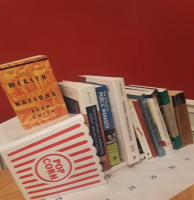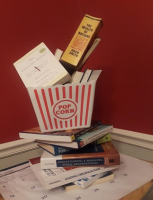A Lifetime of Classics
The views expressed are those of the author and do not necessarily reflect the views of ASPA as an organization.
By Lisa Saye
May 18, 2019

Smith, Gibbons, Eaton, Appleby, D’Agostino, Gladwell, Rubin, Weber and Shafritz and Hyde. What do these and others like them have in common? Plainly, these authors have helped to form the foundation of the theories associated with public administration, and most did so by accident. As scholars, when we revisit the works of these great visionaries, we are compelled to enhance and expand their explanations and revise their constructs as often as the discipline calls for. Public Administration encourages us to go back to the past and rethink the way we do things. That often means rejecting initial tenets that were born out of bias or formed from poorly designed conventions. Public administration authors are known for their desire to provide clarity in implementation. We should strive to contribute to that legacy. Each time we recognize that policy and program evolution are essential for efficiency, we pay tribute to those who showed us the way.
If one were to take inventory of all the public administration degrees, dual degrees, certifications and specializations, they would come away impressed with the body of work the discipline has produced. Any summary one would read includes a brief to lengthy mention of the separation of politics and administration as well as the development of public administration right up to the present day. Each era has its classics and each classic highlights that era’s terminology and best practices. Past classics still represent the blueprint of the study of administration. There are still enough remnants in the pages and paragraphs of each journal article, case study or textbook to help us answer today’s questions about the right thing to do when serving the public. It is true that things and times have changed, but so has our interpretation of every founding doctrine and dogma that went into building the government. And when called upon for contemporary interpretations, time and again public servants have delivered the common narrative in seemingly impenetrable environments.
In 1851, the United States Congress, under then President Millard Fillmore, passed a resolution that required salary classification of public clerks as well as a request for some type of exam for public servants. Those salary ranges and competitive exams would be formally created in the classic Pendleton Act of 1883, but not before the creation and subsequent dissolution of previous Civil Service Commissions. Congress saw the wisdom of having a committed group of public servants, and saw that position classifications were wise in determining some measure for salary. That is not to say that all went smoothly. There were wins, losses and more losses. But through it all, classical narratives set the tone for the discussions that had to occur to meet any meaningful objectives.
From Here to …..
What would public administration authors suggest as the discipline’s most important next steps? How did past authors divine the future at the conclusion of their experiments and research? I think they did what we all do when we discover a conclusion that we were not expecting. I think they determined where the new finding fits in the tree of policy implementation and what the finding said about existing branches of public administration. I believe that in the past they did embrace—and that we still embrace—any application of a new construct that supports and legitimizes the body of literature and study that makes up public administration. I don’t think that they were bored by another question or intimidated by another failure. Past scholars would know where to go from here.

In the above photo, I built a classics tower out of a few textbooks that I keep handy. I could have accomplished the same thing if I had placed an E-Reader on a virtual calendar, but something would be lost in that visual interpretation. As I designed my tower of classics, I realized that I could no longer pile each book from my library in a corner of a room than could the meaning of public administration be summed up for any country or government in a few sentences or policies. That is the single greatest take-away that public administration has to offer. Its classical texts, policies and eras speak volumes about the work its public servants have achieved. Their work is the work that we continue to do today. Their notions of representative service still stand as we give new meaning to its current themes.
Government anywhere is a classic tale of management that is steeped in history and tradition, ultimately racing toward perfection. Its story is long, yet familiar. Its story is broken, yet it endures. These are classic times and our story, our efforts and our commitment are the new classics. Let us rise to the occasion once again and build the future from here.
The images were taken by Lisa Saye.
Author: Lisa Saye teaches Applied Statistics for Public Service and Research Methods for The School of Public Service at DePaul University. She served as Fulbright Specialist in Phnom Penh, Cambodia and as International Consultant for the United Nations Development Program in The Maldives. Saye earned her Master’s in Human Resource Management at Troy University and her Doctorate in Public Administration at The University of Alabama. She can be reached by email at [email protected].




 (8 votes, average: 5.00 out of 5)
(8 votes, average: 5.00 out of 5)
 Loading...
Loading...
A Lifetime of Classics
The views expressed are those of the author and do not necessarily reflect the views of ASPA as an organization.
By Lisa Saye
May 18, 2019
Smith, Gibbons, Eaton, Appleby, D’Agostino, Gladwell, Rubin, Weber and Shafritz and Hyde. What do these and others like them have in common? Plainly, these authors have helped to form the foundation of the theories associated with public administration, and most did so by accident. As scholars, when we revisit the works of these great visionaries, we are compelled to enhance and expand their explanations and revise their constructs as often as the discipline calls for. Public Administration encourages us to go back to the past and rethink the way we do things. That often means rejecting initial tenets that were born out of bias or formed from poorly designed conventions. Public administration authors are known for their desire to provide clarity in implementation. We should strive to contribute to that legacy. Each time we recognize that policy and program evolution are essential for efficiency, we pay tribute to those who showed us the way.
If one were to take inventory of all the public administration degrees, dual degrees, certifications and specializations, they would come away impressed with the body of work the discipline has produced. Any summary one would read includes a brief to lengthy mention of the separation of politics and administration as well as the development of public administration right up to the present day. Each era has its classics and each classic highlights that era’s terminology and best practices. Past classics still represent the blueprint of the study of administration. There are still enough remnants in the pages and paragraphs of each journal article, case study or textbook to help us answer today’s questions about the right thing to do when serving the public. It is true that things and times have changed, but so has our interpretation of every founding doctrine and dogma that went into building the government. And when called upon for contemporary interpretations, time and again public servants have delivered the common narrative in seemingly impenetrable environments.
In 1851, the United States Congress, under then President Millard Fillmore, passed a resolution that required salary classification of public clerks as well as a request for some type of exam for public servants. Those salary ranges and competitive exams would be formally created in the classic Pendleton Act of 1883, but not before the creation and subsequent dissolution of previous Civil Service Commissions. Congress saw the wisdom of having a committed group of public servants, and saw that position classifications were wise in determining some measure for salary. That is not to say that all went smoothly. There were wins, losses and more losses. But through it all, classical narratives set the tone for the discussions that had to occur to meet any meaningful objectives.
From Here to …..
What would public administration authors suggest as the discipline’s most important next steps? How did past authors divine the future at the conclusion of their experiments and research? I think they did what we all do when we discover a conclusion that we were not expecting. I think they determined where the new finding fits in the tree of policy implementation and what the finding said about existing branches of public administration. I believe that in the past they did embrace—and that we still embrace—any application of a new construct that supports and legitimizes the body of literature and study that makes up public administration. I don’t think that they were bored by another question or intimidated by another failure. Past scholars would know where to go from here.
In the above photo, I built a classics tower out of a few textbooks that I keep handy. I could have accomplished the same thing if I had placed an E-Reader on a virtual calendar, but something would be lost in that visual interpretation. As I designed my tower of classics, I realized that I could no longer pile each book from my library in a corner of a room than could the meaning of public administration be summed up for any country or government in a few sentences or policies. That is the single greatest take-away that public administration has to offer. Its classical texts, policies and eras speak volumes about the work its public servants have achieved. Their work is the work that we continue to do today. Their notions of representative service still stand as we give new meaning to its current themes.
Government anywhere is a classic tale of management that is steeped in history and tradition, ultimately racing toward perfection. Its story is long, yet familiar. Its story is broken, yet it endures. These are classic times and our story, our efforts and our commitment are the new classics. Let us rise to the occasion once again and build the future from here.
The images were taken by Lisa Saye.
Author: Lisa Saye teaches Applied Statistics for Public Service and Research Methods for The School of Public Service at DePaul University. She served as Fulbright Specialist in Phnom Penh, Cambodia and as International Consultant for the United Nations Development Program in The Maldives. Saye earned her Master’s in Human Resource Management at Troy University and her Doctorate in Public Administration at The University of Alabama. She can be reached by email at [email protected].
Follow Us!